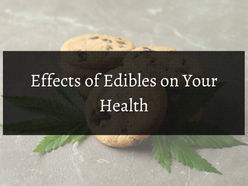How to Use Lecithin in Edibles
- Aaron Killion
- Jul 17
- 4 min read
Lecithin has become a popular additive in edible recipes. It improves texture and cannabinoid absorption, and prevents separation. Many mainstream recipes won’t include lecithin, but adding it to your recipes will give your final products an extra touch of stability.
This ingredient is easy to source and provides benefits for your health as well as your cooking. Choosing the right type of lecithin and knowing how much to use are the keys to achieving the best result.
What Is Lecithin?
Lecithin is a common food additive. It’s mainly used as a natural emulsifying agent to bind fatty and water-based ingredients together.
Why Cannabis Edibles Need Lecithin
Adding lecithin to a baked good like a cookie makes it less likely to fall apart. As part of an infused solution (cannabis oil or butter) or gummy, lecithin helps your edible hold its form and increases its shelf life.
Lecithin is also a valuable addition to cannabis edibles as it increases cannabinoid absorption. There’s a strong reason to include it in your recipes!
Tip: You can purchase high-quality flower to use in your edibles recipes with a valid AZ medical marijuana card, which raises the possession limits in Arizona and exempts you from paying the 16% excise tax.
Sources of Lecithin
Lecithin can be derived from several sources. Some of these are common allergens, making your choice important if you have a food allergy or wish to share your finished products with others.
Soy Lecithin: Soy lecithin is extracted from soybeans. It’s the most common and cost-effective type of lecithin. It’s widely used in the food industry due to its excellent emulsifying properties.
Sunflower Lecithin: Extracted from sunflower seeds. This type of lecithin is best for allergies, as sunflower oil isn’t a common allergen. However, it’s more expensive and less available than soy lecithin.
Egg Lecithin: This type is made from egg yolks. Typically, egg lecithin is used in pharmaceuticals and cosmetics. Using this lecithin will make your products unsuitable for vegans.
Canola Lecithin: This variety is less common, but shares qualities with soy and sunflower lecithin.
Powdered vs Liquid Lecithin
Lecithin comes in both powdered and liquid forms. Liquid lecithin is a viscous, amber-colored fluid that’s less refined than powdered lecithin. This means it retains a large amount of oil from its source. Its composition makes it easy to mix into high-fat recipes like infused coconut oil, butters, or chocolates.
Powdered lecithin undergoes a process that removes most of its oil content. This makes it ideal for dry mixes like baked goods. Powdered lecithin will help products like cookies retain their structure and moisture.
When to Use Powdered and Liquid Lecithin
It’s crucial to know what type of lecithin to use to get your cannabis-infused recipes just right.
Use liquid lecithin for:
Cannabis-Infused Oils and Butter: Liquid lecithin helps to maximize the extraction of cannabinoids into the fat when infusing cannabis into oils or making cannabutter. It also ensures a more even distribution throughout the entire batch for consistent dosing.
Cannabis Chocolates: Liquid lecithin improves the texture of chocolate and prevents separation.
Cannabis Gummies or Other Gelatin-Based Edibles: Liquid lecithin stabilizes the gummy mixture and ensures the oil content is evenly distributed.
Use powdered lecithin for:
Baked Goods: Powdered lecithin helps stabilize bread, cookies, muffins, cakes, and many other baked goods.
Where to Find Lecithin
You can buy lecithin online, in health-food stores, and in supermarkets—generally in the vitamin, natural foods, or baking section. Check the packaging for the relevant symbols (vegetarian, vegan, kosher, etc.) if you have special dietary requirements.
How Much Lecithin to Use in Edibles Recipes
The rules of thumb for using powdered lecithin are:
Add one teaspoon of lecithin powder per cup of oil in your recipes.
Add 1 1/2 teaspoons for each egg used for baked goods.
The rule of thumb for using liquid lecithin is much broader. You may find recipes suggesting anywhere from a teaspoon to a tablespoon of lecithin per cup of oil or butter.
Use less if you’re aiming for a subtle effect on texture. Add more if your recipe has a very high fat content or you need a highly stable emulsification, for example, in gummy recipes.
Remember to mix all your ingredients thoroughly after you add lecithin. It has a strong taste, and uneven distribution could taint the flavor of your finished products.
Health Benefits of Lecithin
Natural lecithin has several health benefits in addition to improving the bioavailability of cannabinoids:
Helps to balance “good” and “bad” cholesterol
Supports heart health
Helps to reduce the thickness of breast milk, potentially preventing clogged ducts in breastfeeding mothers (See our article on marijuana and breastfeeding before consuming infused edibles as a nursing mother.)
Has moisturizing properties when applied topically
Lecithin Adds an Expert Touch to Edibles
Incorporating lecithin into your homemade cannabis edibles is a simple yet powerful way to elevate their quality, potency, and consistency. Lecithin improves texture, extends shelf life, and plays a crucial role in enhancing cannabinoid absorption.
Lecithin comes from a range of sources, is available in liquid and powdered forms, and is easy to find and purchase. Experiment with confidence, and enjoy the enhanced experience that lecithin brings to your infused creations.















